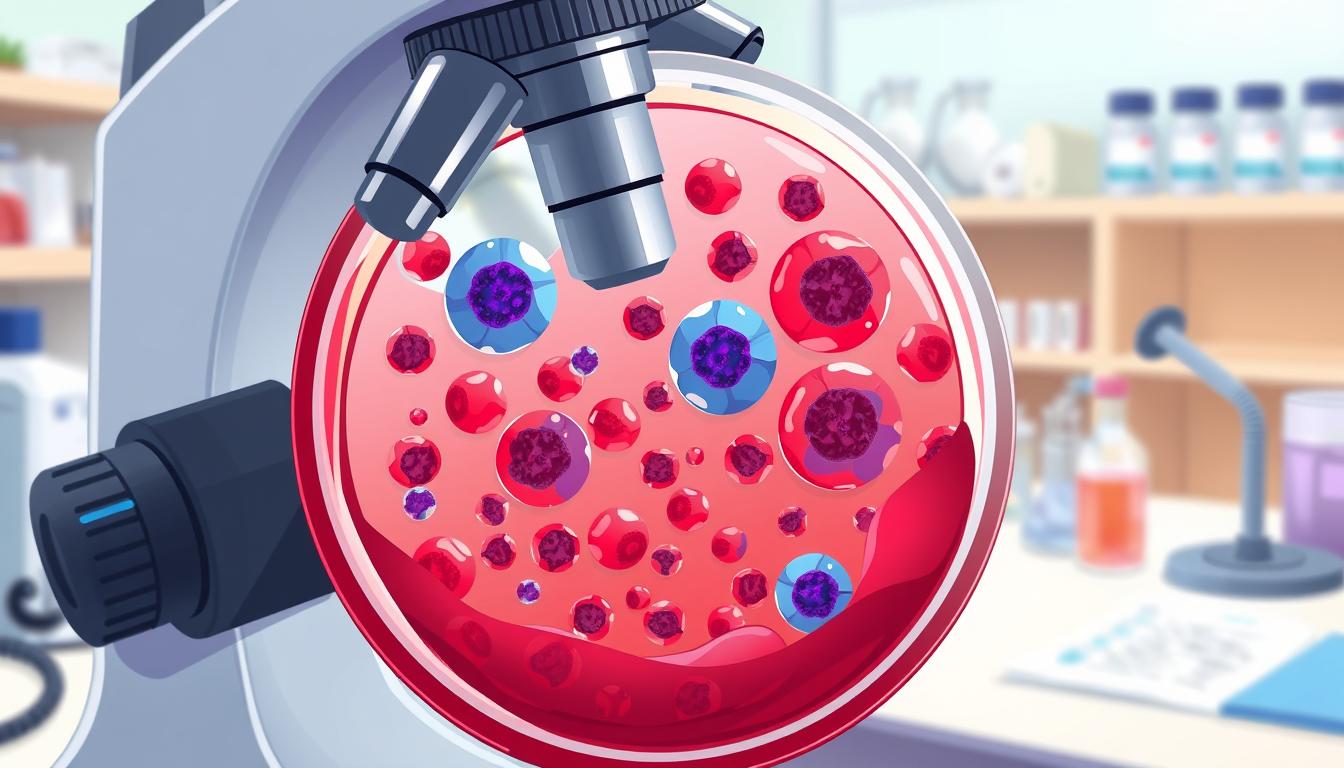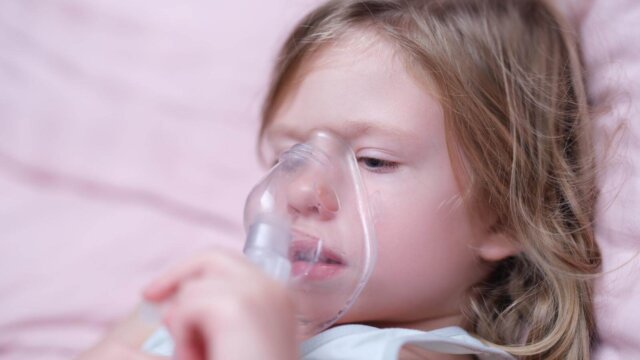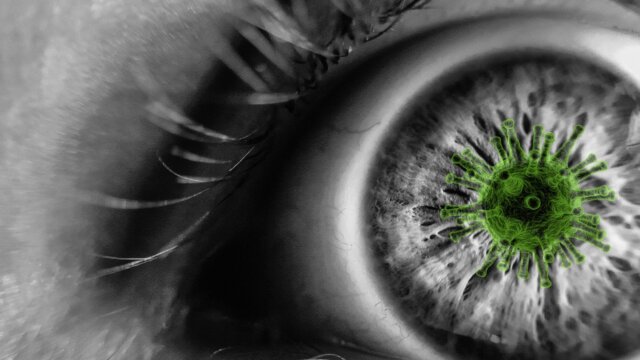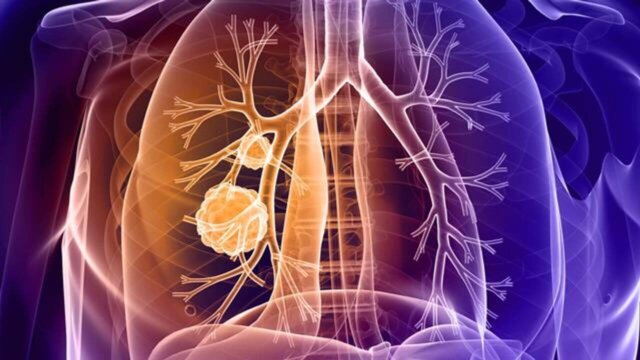FTC disclaimer: This post may contains affiliate links and we will be compensated if you click on a link and make a purchase.
Chronic lymphocytic leukemia (CLL) is a common blood cancer in adults. It affects about 21,000 people in the United States each year. It starts in the bone marrow, where lymphocytes grow too much and fill the blood.
As CLL gets worse, these bad cells can move to other places like the lymph nodes, liver, and spleen. This can cause many symptoms and problems.
Key Takeaways
- Chronic lymphocytic leukemia (CLL) is one of the most common types of leukemia in adults.
- CLL is a type of blood cancer that starts in the bone marrow and affects the lymphocytes, a type of white blood cell.
- The average age of CLL diagnosis is in the late 60s, and the disease is more common in whites than in other racial or ethnic groups.
- CLL often progresses slowly, and many people may not experience any symptoms for years.
- Treatments for CLL include watchful waiting, targeted therapy, chemotherapy, and immunotherapy, with the goal of slowing disease progression and achieving long periods of remission.
What is Chronic Lymphocytic Leukemia?
Chronic lymphocytic leukemia (CLL) is a cancer that affects white blood cells called lymphocytes. It’s common in adults and starts in the bone marrow. CLL grows slowly, causing symptoms to appear over time and spread to other parts of the body.
CLL makes it hard for white blood cells to fight infections. It’s more common in older adults and white people. Risk factors include age, race, family history, chemical exposure, and conditions like Monoclonal B-cell lymphocytosis (MBL).
CLL and small lymphocytic lymphoma (SLL) are the same disease. CLL happens when cancer cells are mostly in the blood and bone marrow. SLL occurs when they’re mostly in the lymph nodes.
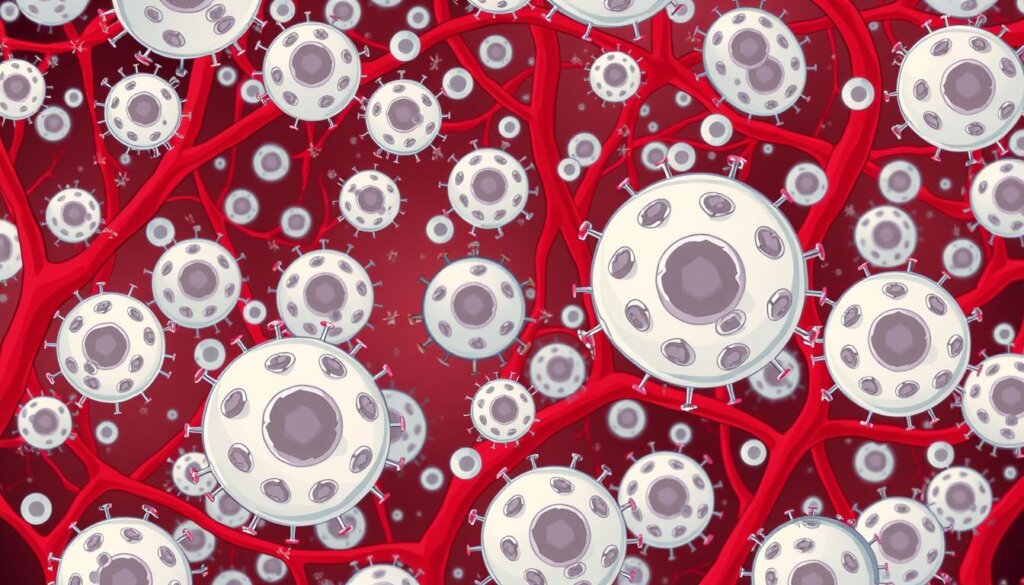
CLL has different types, each with its own growth rate and treatment response. For example, prolymphocytic leukemia (PLL) grows and spreads faster than CLL. Large granular lymphocyte (LGL) leukemia is rare and has varied growth rates and treatment challenges.
CLL can lead to serious infections, a switch to aggressive cancer, and other cancer risks. It also weakens the immune system.
Top cancer hospitals like the Mayo Clinic in Rochester, Minnesota, and others offer CLL treatment.
Types of Leukemia
Myeloid and Lymphocytic Leukemia
Leukemia is a blood cancer that starts in the bone marrow. This is where blood cells are made. There are two main types: myeloid and lymphocytic.
Chronic lymphocytic leukemia (CLL) is the most common in adults. It happens more often than other types in adults. On the other hand, acute myeloid leukemia (AML) is common in adults.
Lymphocytic leukemias start in cells that become lymphocytes, a type of white blood cell. CLL starts in early white blood cells in the bone marrow. Lymphomas also start in these cells but are different because the cancer cells are mainly in lymph nodes and tissues.
Myeloid leukemias start in cells that become red blood cells, platelets, and certain white blood cells. Hairy cell leukemia (HCL) is rare in adults. Acute lymphocytic leukemia (ALL) is common in children.
Type of Leukemia | Description | Prevalence |
|---|---|---|
Chronic Lymphocytic Leukemia (CLL) | The most common chronic leukemia in adults, starts in lymphocytes in the bone marrow. | CLL accounts for about 25 percent of all leukemia cases, and approximately one in every 175 people may develop CLL in their lifetime. |
Acute Myeloid Leukemia (AML) | One of the most common leukemias in adults, starts in cells that would normally become other types of blood cells. | Approximately 15 percent of leukemias are Chronic Myeloid Leukemia (CML), and about half of CML cases are diagnosed through a blood test before symptoms begin. |
Hairy Cell Leukemia (HCL) | A rare cancer in adults that starts in the bone marrow. | HCL affects about 700 people annually according to the American Society of Clinical Oncology. |
Acute Lymphocytic Leukemia (ALL) | The most common form of leukemia in children, starts in early forms of white blood cells called lymphocytes. | About 10,000 people are diagnosed with Myelodysplastic syndromes (MDS) each year, per the American Cancer Society. |

In summary, leukemia is divided into two main types: myeloid and lymphocytic. Knowing the different types is key for the right diagnosis and treatment.
Chronic vs. Acute Leukemia
Leukemia comes in two main types: chronic and acute. Chronic leukemia grows slowly, needing long-term management. There are four main types: AML, CML, ALL, and CLL.
Chronic leukemia takes years to progress, giving patients more time to live their lives. Symptoms include tiredness, bone pain, weight loss, anemia, and infections.
Acute leukemia, on the other hand, develops fast and needs quick treatment. Symptoms include low white blood cell counts, infections, tiredness, pale skin, and easy bruising.
Risk factors for chronic leukemia include being over 60, exposure to chemicals like benzene, and genetics. Acute leukemia risks include smoking, genetic disorders, and radiation exposure.
The Leukemia & Lymphoma Society reports 5-year survival rates. CML has a 71.7% rate, CLL an 88.6% rate, ALL a 72.1% rate, and AML a 29.8% rate. New treatments are improving survival rates.
No early screening tests exist for leukemia. But, monitoring and reporting symptoms to a doctor can help in early detection and treatment.
Type of Leukemia | 5-Year Survival Rate |
|---|---|
Chronic Myeloid Leukemia (CML) | 71.7% |
Chronic Lymphocytic Leukemia (CLL) | 88.6% |
Acute Lymphocytic Leukemia (ALL) | 72.1% |
Acute Myeloid Leukemia (AML) | 29.8% |
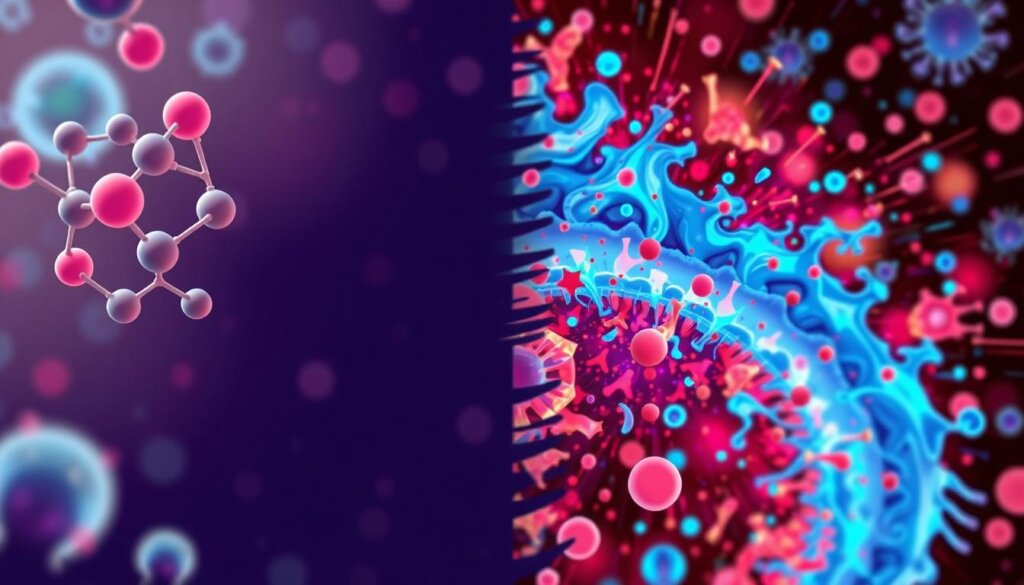
Chronic and acute leukemia differ in progression rate, types, symptoms, and survival rates. Knowing these differences is key for timely and effective treatment.
Chronic leukemia progresses slowly. CLL is the most common leukemia in adults. ALL is more aggressive and common in children.
Risk factors for ALL include family history, genetic conditions, and benzene exposure. CLL risks include Agent Orange exposure, family history, and age over 50. Treatments for ALL and CLL vary, with no preventive measures known.
“Getting a cancer diagnosis for either ALL or CLL can feel overwhelming, but seeking support from friends, family, or support groups is recommended.”
Understanding chronic and acute leukemia, as well as their types, risks, and treatments, is crucial for patients and healthcare providers.
Symptoms of Chronic Lymphocytic Leukemia
Common Symptoms
Many people with CLL don’t show symptoms when first diagnosed. But as the cancer grows, symptoms like weakness and fatigue appear. Other signs include weight loss, chills, fever, and swollen lymph nodes.
Abdominal pain, fullness, and frequent infections are also common. Anemia can cause tiredness and shortness of breath. Low white blood cells make infections more likely. Low blood platelets can lead to bruising and bleeding.
CLL patients are more prone to infections because their immune system is weak. The cancer can also cause the immune system to attack normal blood cells. This can lead to anemia, low platelet counts, or low white blood cell counts.
Seeking medical help is crucial for an accurate diagnosis and treatment.
CLL often starts slowly, with no symptoms at first. Symptoms include swollen lymph nodes, fever, and fatigue. Other signs are abdominal pain, night sweats, weight loss, and more infections.
CLL mostly affects people over 60, with rare cases in those under 45. Symptoms include enlarged lymph nodes, liver, or spleen. Other signs are excessive sweating, fatigue, fever, and loss of appetite.

“CLL is a complex disease, and its symptoms can vary from person to person. It’s important to be aware of the potential signs and seek medical attention if you notice any changes in your health.”
Causes and Risk Factors
The exact causes of chronic lymphocytic leukemia (CLL) are still unknown. But, researchers have found some factors that might raise the risk of getting this blood cancer. Most CLL cases are linked to DNA changes, especially those that turn on bad genes or turn off good ones. In most CLL cases, a change is found in at least one of the 23 pairs of chromosomes in a human cell.
The most common chromosome changes in CLL are the loss of part of chromosome 13, known as del(13q), followed by deletions in chromosomes 11 and 17. Sometimes, an extra chromosome 12 (trisomy 12) is present in CLL cases. Inherited mutations rarely cause CLL, with DNA changes related to CLL usually occurring during a person’s lifetime.
Other risk factors for CLL include:
- Age: CLL occurs most often in older adults, with the average age of diagnosis being 70 years.
- Race: White people are more likely to develop CLL compared to other racial groups.
- Family history: Having a close relative with blood or bone marrow cancer can increase the risk of CLL.
- Exposure to certain chemicals: Some studies suggest a possible link between exposure to certain chemicals and an increased risk of CLL.
- Monoclonal B-cell lymphocytosis (MBL): This condition, which causes an increased number of one type of lymphocyte, may be a precursor to CLL.
Understanding CLL’s causes and risk factors is key for early detection and management. Regular check-ups and blood tests can spot CLL early.
Diagnosis and Staging
Chronic lymphocytic leukemia (CLL) is often found during routine blood tests or a physical exam. Doctors might find swollen lymph nodes. More tests, like blood tests and bone marrow biopsies, confirm the diagnosis and disease stage.
The Rai staging system has 5 stages for CLL. Stage 0 has more lymphocytes but no swollen lymph nodes or organs. Stage I has swollen lymph nodes but normal spleen and liver, and normal blood counts. Stage III has swollen lymph nodes, spleen, or liver, and low blood counts.
Rai stages I and II are considered intermediate risk. Stages III and IV are at high risk for treatment.
The Binet staging system has stages A, B, and C for CLL. Binet stage A has fewer than 3 swollen lymph nodes, no anemia, and no low platelet counts. Binet stage C has anemia and/or low platelet counts.
Genetic changes, bone marrow involvement, age, and blood markers affect CLL prognosis. Favorable factors include certain genetic changes and bone marrow patterns. Adverse factors include widespread bone marrow involvement, advanced age, and specific genetic deletions.
CLL is similar to other blood cancers like hairy cell leukemia and small lymphocytic lymphoma (SLL). Monoclonal B-cell lymphocytosis (MBL) has fewer than 5,000 monoclonal lymphocytes. It may turn into CLL in about 1 out of 100 cases.
Treatment Options
The treatment for chronic lymphocytic leukemia (CLL) varies based on the disease stage and health. Some may just watch and wait, with doctors keeping a close eye.
For others, treatments like chemotherapy, targeted therapies, and immunotherapy are used. Sometimes, a stem cell transplant is needed. The choice depends on the disease stage, age, health, and genetic changes.
Watchful Waiting and Active Treatment
Early-stage CLL patients without symptoms might just watch and wait. This means regular check-ups without starting treatment right away. Treatment starts when the disease gets worse or symptoms appear.
When treatment is needed, several options are available. These include:
- Chemotherapy: Drugs like fludarabine, cyclophosphamide, and rituximab (FCR regimen) kill fast-growing cells.
- Targeted Therapies: Medications target CLL cells’ genetic mutations or pathways, such as BTK inhibitors (e.g., ibrutinib, acalabrutinib) and BCL-2 inhibitors (e.g., venetoclax).
- Immunotherapy: Treatments use the body’s immune system to fight cancer, like monoclonal antibodies (e.g., rituximab, obinutuzumab).
- Stem Cell Transplant: Replaces damaged bone marrow with healthy stem cells, often for high-risk CLL patients.
Treatment Option | Description |
|---|---|
Chemotherapy | Drugs that kill rapidly dividing cells, such as fludarabine, cyclophosphamide, and rituximab (FCR regimen). |
Targeted Therapies | Medications that target specific genetic mutations or pathways in CLL cells, like BTK inhibitors (e.g., ibrutinib, acalabrutinib) and BCL-2 inhibitors (e.g., venetoclax). |
Immunotherapy | Treatments that harness the body’s immune system to fight cancer, such as monoclonal antibodies (e.g., rituximab, obinutuzumab). |
Stem Cell Transplant | A procedure that replaces damaged or destroyed bone marrow with healthy stem cells may be recommended for high-risk CLL patients. |
Choosing active treatment depends on many factors. These include age, health, and genetic mutations.
“Treatment for chronic lymphocytic leukemia depends on the stage of the disease and the individual’s overall health. For some patients, a ‘watchful waiting’ approach may be recommended, where the doctor closely monitors the disease without immediate treatment.”
Chronic Lymphocytic Leukemia Complications
Chronic lymphocytic leukemia (CLL) can cause many problems that need careful watching and treatment. One big issue is getting sick more often because the immune system is weak. Doctors might use antibiotics, special medicines, shots, and growth factors to fight these problems.
Another big problem is Richter’s syndrome when CLL turns into a more serious cancer. This happens in 2% to 10% of CLL patients. Also, 4% to 10% of CLL patients face autoimmune issues, like their body attacking its own blood cells.
Dealing with CLL can also cause side effects, like swelling in lymph nodes with lenalidomide. Another serious risk is tumor lysis syndrome, especially in those with big lymph nodes.
People with CLL are also at higher risk of getting another type of cancer. This is more likely in older men over 60.
It’s very important for doctors to watch CLL patients closely for these issues. They need to treat and support them well to improve their life quality.
Living with Chronic Lymphocytic Leukemia
Living with chronic lymphocytic leukemia (CLL) can be a mix of challenges and chances. Getting diagnosed might feel scary, but many people with CLL live for years without treatment. The goal is to handle symptoms, deal with treatment side effects, and keep a good quality of life.
CLL is special because some patients might not need treatment right away. About 27,000 people in the UK are watching their condition but not treating it. This “watch and wait” time can be when people with early CLL feel okay and live well.
But CLL can still be tough, both physically and emotionally. Patients might need to change their lifestyle to manage the disease. Treatments can cause side effects like tiredness, nausea, and skin issues, making daily life harder. Getting support from doctors, family, and friends and joining support groups is very helpful.
Staying healthy is key for CLL patients. Eating well, exercising, and managing stress can help with side effects and improve health. Things like acupuncture, massage, and meditation can also help you feel better and improve well-being.
Even though CLL’s journey is unpredictable, there are ways to cope. By working with doctors, taking care of yourself, and getting emotional support, CLL patients can aim for the best life.
Key Considerations for Living with CLL | Strategies and Recommendations |
|---|---|
Managing Symptoms and Side Effects |
|
Coping with Emotional Challenges |
|
Maintaining Quality of Life |
|
“The key to living well with CLL is to focus on managing the practical and emotional aspects of the disease, while also prioritizing self-care and maintaining a positive outlook.”
Research and Clinical Trials
Researchers are always trying to learn more about chronic lymphocytic leukemia (CLL). They work on new treatments. Clinical trials test new drugs to see if they work and are safe. Patients with CLL might get to try these new treatments in trials.
There are trials for different CLL stages, like when it’s first found or when it comes back. For example, the “MAJIC” Phase 3 trial and the “SAVE” Phase 1b study are ongoing. Dr. Matthew Davids, Dr. Inhye Ahn, and Dr. Jennifer Crombie are leading these efforts.
They also focus on moving research into real-world treatments. This means studying CLL cells and their genetics. A study led by Dr. Jennifer Brown is looking for genes that cause CLL. This could help prevent and diagnose it better.
Research and trials are key to fighting CLL. Trying new treatments in trials is a good option for CLL patients. It offers the best treatments and might lead to new ones. New drugs and immunotherapy are changing how CLL is treated.
Joining trials is important for CLL patients. It gives them access to new treatments and helps research. The work of researchers and patients in trials is crucial for finding better CLL treatments.
Clinical Trial | Phase | Principal Investigator | Highlights |
|---|---|---|---|
MAJIC | Phase 3 | Dr. Matthew Davids | Evaluating new treatment approaches for CLL |
SAVE | Phase 1b | Dr. Inhye Ahn | Studying novel targeted therapies for CLL |
CRC043 | Phase 2 | Dr. Jennifer Crombie | Investigating immunotherapy options for CLL |
Research and trials are vital for CLL. By joining trials, patients get new treatments and help find better ones.
Conclusion
Chronic lymphocytic leukemia (CLL) is a blood cancer that affects white blood cells. It’s not very common, with only 4.2 cases per 100,000 people in Western countries. But it can really change someone’s health and life.
Most people get CLL when they’re 72 years old. Only about 10% are younger than 55. By 80, the number of cases goes up to 30 per 100,000 people. Things like gender, race, and family history can also play a part.
New research and treatments are making a big difference for CLL patients. By keeping up with the latest treatments and trials, people can work with their doctors. This helps them manage their disease and live well.
FAQ
What is chronic lymphocytic leukemia (CLL)?
CLL is a cancer that affects white blood cells called lymphocytes. It makes these cells build up in the blood, bone marrow, and lymph nodes. This crowds out normal blood cells.
How is CLL different from other types of leukemia?
CLL is a lymphocytic leukemia, starting in lymphocytes. It’s different from myeloid leukemia. CLL cells are mostly in the blood and bone marrow. Lymphomas have cells mainly in lymph nodes and other tissues.
What are the common symptoms of CLL?
At first, many CLL patients don’t have symptoms. Later, symptoms like swollen lymph nodes, fatigue, fever, and infections may appear.
What causes CLL, and who is at risk?
CLL’s exact cause is unknown. But, age, race, family history, and exposure to chemicals may increase risk. A condition called monoclonal B-cell lymphocytosis (MBL) also raises risk.
How is CLL diagnosed and staged?
CLL is often found during routine blood tests or physical exams. Tests like blood tests and bone marrow biopsies confirm the diagnosis and stage. This helps plan treatment.
What are the treatment options for CLL?
CLL treatment varies based on disease stage and health. Options include watching and waiting, chemotherapy, and targeted therapies. Treatment choices depend on disease stage, age, health, and genetic changes.
What are the potential complications of CLL?
CLL can cause infections, a more aggressive cancer form, and other cancers. It can also lead to autoimmune problems like anemia and thrombocytopenia.
How can people living with CLL maintain their quality of life?
Many CLL patients live for years without treatment. But, the diagnosis can be tough. Managing symptoms, coping with side effects, and making lifestyle changes help. Support from healthcare, family, and friends is key.
How is research advancing the understanding and treatment of CLL?
Ongoing research aims to understand CLL better and find new treatments. Clinical trials test new drugs and approaches. Participating in trials can offer access to new therapies. Research and trials are crucial for CLL progress.
